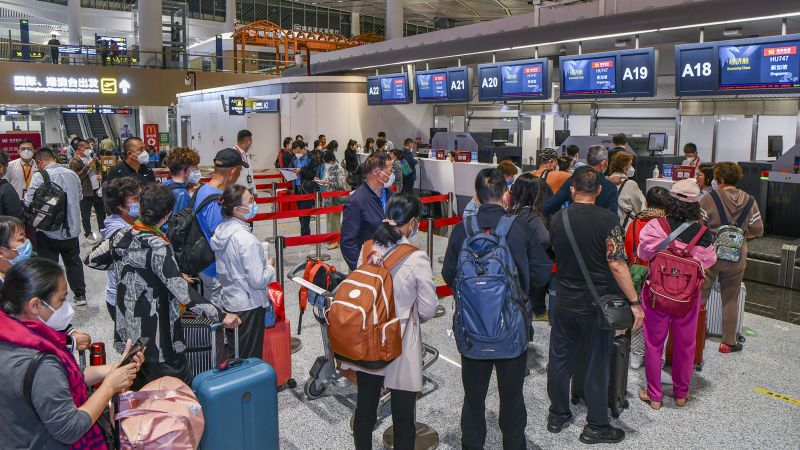
Hong Kong
CNN
—
Travelers across Asia Pacific will likely continue to fork out more than usual for flights this year, even as planes return to the skies at a rate not seen since the start of the pandemic.
Airfares within the region were 33% higher in February than the same month in 2019, compared with increases of 12% and 17% in Europe and North America, respectively, according to data from Skyscanner Travel Insight.
In some cases, customers are paying twice what they did four years ago.
A business class ticket from Paris to Shanghai that would have cost approximately $5,650 in 2019 has now doubled to more than $11,500, according to American Express Global Business Travel (Amex GBT). The firm is a travel platform that was spun off from the eponymous credit card company.
The average price for a business class seat from Singapore to Shanghai is also double 2019 levels, says Amex GBT.
The surge is part of a broader trend. Flight tickets globally are generally higher than pre-Covid levels due to a myriad of factors, noted Hugh Aitken, vice president of flights at Skyscanner.
But passengers in Asia Pacific are currently grappling with bigger price jumps than other regions, highlighting the uneven global recovery.
The problem isn’t expected to end anytime soon.
Economy fares to Asia from North America and Europe are set to rise 9.5% and 9.8% this year from last year, respectively, Amex GBT forecasts show. The latter is almost double the projected price jump for European economy routes to other geographies. A similar outlook is expected for the business class cabin.
Experts say that soaring costs, labor shortages and the closure of Russian airspace are all pushing up prices.
The main constraint, however, is that Asia is still in the early stages of reopening.
Unlike North America and Europe, which have long relaxed border restrictions, most Asian destinations, such as Japan and South Korea, only reopened for travel in 2022.
Mainland China only lifted quarantine restrictions for international arrivals in January after three years and last week resumed issuing visas for all visitors, including tourists.
“In the markets where restrictions have been the last to lift, and hence [flight] capacity last to be restarted, the difference in fares is the highest,” said Aitken. “Right now, this is in APAC.”
Even when demand is there, it’s not easy for airlines to immediately add service. They often require long lead times to position crew and ground staff, coordinate with airports and relocate aircraft, said Jeremy Quek, Amex GBT’s principal global air practice line lead.
“Planning an airline schedule takes months,” he noted.
The numbers reflect that. Despite China’s reopening, outbound flight capacity “is currently only at 15% to 20% of pre-Covid levels,” according to Trip.com
(TCOM) CEO Jane Sun.
In an earnings call this month, she said the bottleneck was “largely limiting the overall recovery pace of China’s outbound travel.”
Meanwhile, flight capacity for long-haul international routes, such as those between Europe and Asia, is at just 17% of 2019 levels this quarter, according to Amex GBT.
“Even though airline capacity is coming back, it’s not coming back at the same pace as we expect the pent-up demand to be. That’s where the crux is,” said Quek.
“Reduced capacity, and growing demand, is the formula for rising prices.”
Last year, Russia sealed off its airspace to airlines from dozens of countries as its invasion of Ukraine started.
As a result, many flights have been forced to reroute, making trips longer and more expensive. The restrictions have remained, and those most heavily impacted are between Asia and North America or Europe.
“For example, a flight from Tokyo to London which now has to head east over the North Pacific, Alaska, Canada, and Greenland has to add 2.4 hours of flight time and is likely to burn around 5,600 gallons more fuel, a 20% increase,” Amex GBT said in a report.
The cost of fuel itself has skyrocketed, too. Alan Joyce, CEO of Australian flagship carrier Qantas
(QABSY), said his company’s fuel bill was 65% higher than in 2019.
“Airfares will have to be higher than they were before Covid, because fuel is higher,” he said in a speech this month.
Joyce also said the carrier was incurring higher expenses, and needed time to retrain crew who had been out of commission during the pandemic.
“Our pilots were driving buses in Sydney and Melbourne for a while because they were stood down. So to get a pilot back, we have to put them through 23 hours of simulator training and five sectors of flying,” he explained.
Despite the sticker shock for some travelers, experts don’t believe people will be deterred from taking trips, or that the overall recovery of the sector will be damaged.
“Currently, we are not seeing any signs of impact on consumer confidence and traveler demand. We are seeing sustained strong demand across Skyscanner platforms for travel in 2023,” said Aitken.
Sun said she anticipated the recovery in outbound Chinese travel to “pick up the pace in the coming quarters” as airlines continued to restore service.
Some airlines have also deftly adapted to an outcry over prices by offering catchy discounts.
Qantas and its budget carrier, Jetstar, have announced discounts on more than 1 million seats this year on a mix of domestic and international routes.
Japan Airlines has also tried to mark down tickets for its customers, though its efforts have been met with a bigger surge in demand than anticipated.
The carrier’s website crashed earlier this month when it tried to roll out a campaign for discounted domestic flights.
“Our system was unable to handle the traffic,” the company said in a statement.
Prices aren’t rising on every route. Aitken said consumers should “still be able to find competitively priced flights, particularly if they can be flexible on when and where they go.”
Fares from the United Kingdom to Vietnam, or the United States to Malaysia, for example, are both slightly down for bookings later this year, compared to a year before, he added.
“In the current climate, the most straightforward way for travelers to find good deals is to book early,” advised Aitken.

